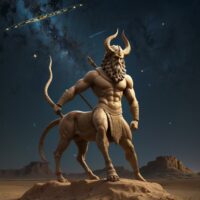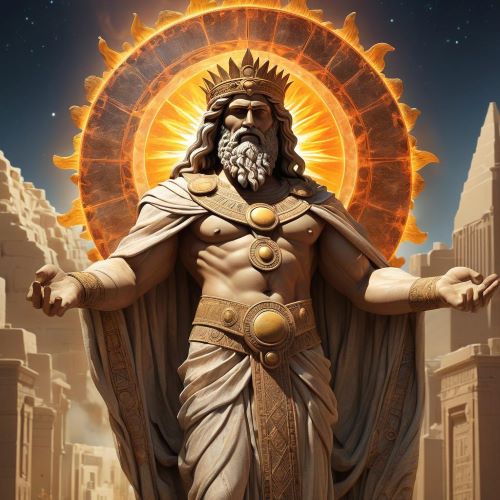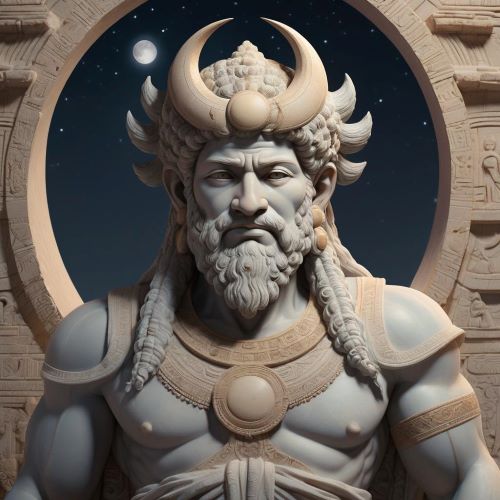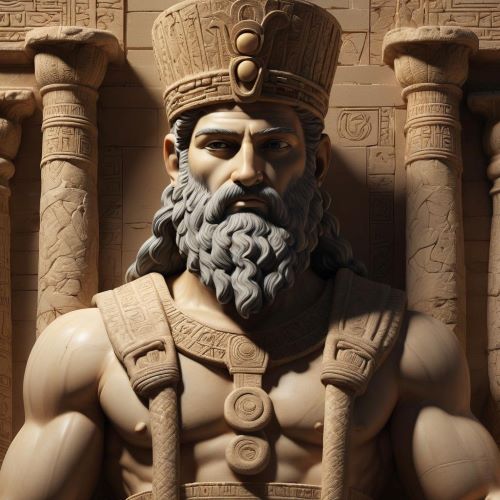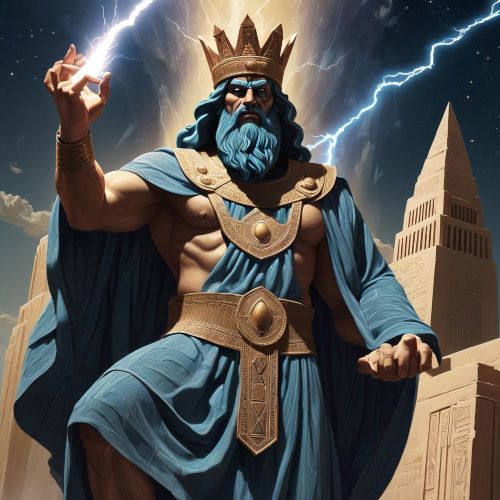Pabilsag : The Warrior God
Listen
At a glance
| Description | |
|---|---|
| Origin | Babylonian Mythology |
| Classification | Gods |
| Family Members | Nininsinna (Wife), Enlil (Father) |
| Region | Iraq |
| Associated With | Protection, |
Pabilsag
Introduction
Pabilsag is a compelling yet underappreciated deity from ancient Mesopotamian mythology. Predominantly worshipped in the city of Larak and later acknowledged in Isin and Lagash, Pabilsag’s identity blends warrior prowess, divine judgment, and celestial authority. Though overshadowed by gods like Enlil or Ninurta, Pabilsag held a distinct place in the spiritual landscape of Sumerian and Babylonian cultures. What sets him apart is not just his multifaceted nature but also his enduring legacy as the earliest known deity associated with the zodiac sign Sagittarius. His mythology, though not extensively documented, reflects the rich tapestry of Mesopotamian religious thought and cosmic symbolism.
Physical Traits
Depictions of Pabilsag are striking and symbolic. He is most often imagined in an astral form that prefigures the constellation Sagittarius—a figure combining human intelligence, animal strength, and divine elements. His composite body typically includes the torso of a man armed with a bow, the body of a four-legged beast (often equine), wings suggesting celestial movement, and a scorpion’s tail as a nod to his fiercer qualities. This hybrid form is not merely artistic flourish—it represents the fusion of opposites: man and beast, heaven and earth, life and death.
In one poetic description, he’s referred to as a “wild bull with multicolored legs,” further emphasizing his untamed and otherworldly nature. The wings, often left out in later Greek interpretations of Sagittarius, symbolize his divine mobility, while the scorpion tail may hint at a connection to the netherworld or a hidden sting, both literally and metaphorically.
Family
Pabilsag’s divine lineage roots him within the upper echelons of Mesopotamian cosmology. He is generally recognized as the son of Enlil, the supreme sky god, and Nintur, a goddess of birth and creation. This parentage situates him among powerful divine company, reflecting both inherited strength and cosmic responsibility.
His marriage to Ninisina (also known as Gula or Ninkarrak) is of particular significance. Ninisina was a goddess of healing, and through this union, Pabilsag gained association with medicinal and protective functions. Their children—Damu, Gunura, and Šumaḫ—were also linked to healing and rejuvenation. In a world where gods reflected the needs of daily life, this familial network embodied both protection in battle and healing in sickness, making Pabilsag and his kin revered figures in times of crisis.
Other Names
Pabilsag was known by multiple names and titles, reflecting regional variations and theological syncretism. Among them is “Lugal-Isin,” suggesting his prominence in the city of Isin, possibly as its king or chief protector. Another title, Erimabinutuku, likely refers to a warrior attribute or sacred weapon, emphasizing his martial strength. He also appears simply as “PA” in god lists—a shorthand that underscores his familiarity among scribes and priests.
In astronomical texts, he is identified directly with Sagittarius, a celestial designation that persists today. These varying names demonstrate how Pabilsag’s identity evolved across time and space, often merging with or being absorbed by other deities such as Ninurta and Ningirsu. Such fluid identities were common in Mesopotamian religion, where gods were as dynamic as the people who worshipped them.
Powers and Abilities
Pabilsag’s role was not limited to one domain. As a god of war, he was invoked for protection and victory, especially with his iconic bow. This imagery positioned him as a defender of the righteous and an enforcer of divine order. But his power extended beyond the battlefield. As a cadastral officer—essentially a divine judge of land and law—he was responsible for overseeing boundaries and fairness, a role that highlights Mesopotamia’s deeply administrative view of the divine.
His connection to healing emerged through his consort Ninisina, making him a protector in more than just combat. Some traditions even place him in proximity to the underworld, where he is said to have exercised influence, possibly through a syncretic link with Nergal, the god of death and plague. These associations positioned Pabilsag as a guardian at the crossroads of life and death.
Celestially, his embodiment as the constellation Sagittarius granted him an enduring place in the sky. He was thought to guide cosmic navigation and perhaps even weather patterns. Observations of Jupiter in the region of Pabilsag’s constellation were seen as omens of seasonal change, linking him to timekeeping and fate.
Modern Day Influences
While modern worship of Pabilsag has faded, his essence endures—most notably through the zodiac. Sagittarius remains one of the most recognized astrological signs, still symbolized by the archer figure rooted in Pabilsag’s imagery. This enduring symbol represents a quest for truth, exploration, and independence—qualities that align with the ancient deity’s celestial identity.
Academic interest in Pabilsag continues, particularly among scholars studying Mesopotamian astronomy and its influence on later cultures. His story contributes to understanding how the ancients merged theology with practical knowledge, using gods to explain both moral order and the stars above.
His hybrid imagery—part man, part beast, part divine—has inspired various media, from fantasy literature to video games. Characters resembling centaur archers, divine judges, or mystical warriors often echo Pabilsag’s symbolic complexity. In anime like Saint Seiya, for example, the Sagittarius Cloth bears features reminiscent of Pabilsag’s form, albeit adapted for a modern audience.
In comparative mythology, Pabilsag is often paralleled with figures such as Chiron, the wise centaur of Greek myth, or Arjuna, the divine archer of the Mahabharata. These comparisons underscore a shared human fascination with the archer archetype—a seeker of destiny, justice, and knowledge.
Related Images
Source
Black, J., & Green, A. (1998). Gods, Demons and Symbols of Ancient Mesopotamia: An Illustrated Dictionary. University of Texas Press.
George, A. R. (1993). House Most High: The Temples of Ancient Mesopotamia. Eisenbrauns.
Krebernik, M. (2003–2005). Pabilsag. In Reallexikon der Assyriologie und Vorderasiatischen Archäologie (Vol. 10, pp. 161–168). Walter de Gruyter.
Lambert, W. G. (2013). Babylonian Creation Myths. Eisenbrauns.
Ancient Mesopotamian Gods and Goddesses – Pabilsag (god) – Oracc. (n.d.). https://oracc.museum.upenn.edu/amgg/listofdeities/pabilsag/index.html
Ancient Mesopotamian Religion: The Healing Goddess. (2015). https://digital.csic.es/handle/10261/125303
Pabilsag – Mythical Encyclopedia. (n.d.). https://mythicalencyclopedia.com/pabilsag/
Pabilsag | Myths in Media Wiki – Fandom. (n.d.). https://myths-in-media.fandom.com/wiki/Pabilsag
Pabilsag: The Celestial Guardian of Ancient Mesopotamia. (2023, November 27). https://realmwhispers.com/arthropods/pabilsag-protector-of-the-celestial-gateway/
The Mesopotamian Pantheon. (2011). https://www.worldhistory.org/article/221/the-mesopotamian-pantheon/
Frequently Asked Questions
What is lorem Ipsum?
I am text block. Click edit button to change this text. Lorem ipsum dolor sit amet, consectetur adipiscing elit. Ut elit tellus, luctus nec ullamcorper mattis, pulvinar dapibus leo.
What is lorem Ipsum?
I am text block. Click edit button to change this text. Lorem ipsum dolor sit amet, consectetur adipiscing elit. Ut elit tellus, luctus nec ullamcorper mattis, pulvinar dapibus leo.
What is lorem Ipsum?
I am text block. Click edit button to change this text. Lorem ipsum dolor sit amet, consectetur adipiscing elit. Ut elit tellus, luctus nec ullamcorper mattis, pulvinar dapibus leo.
What is lorem Ipsum?
I am text block. Click edit button to change this text. Lorem ipsum dolor sit amet, consectetur adipiscing elit. Ut elit tellus, luctus nec ullamcorper mattis, pulvinar dapibus leo.
What is lorem Ipsum?
I am text block. Click edit button to change this text. Lorem ipsum dolor sit amet, consectetur adipiscing elit. Ut elit tellus, luctus nec ullamcorper mattis, pulvinar dapibus leo.



